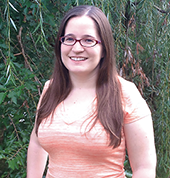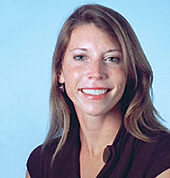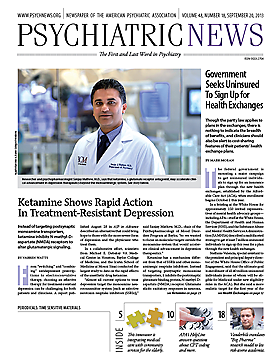When it comes to acquiring enthusiastic young members, the Indiana Psychiatric Society (IPS) is on a roll.
A few years ago, only about 10 percent of Indiana psychiatry residents at most attended IPS meetings. Today, there is so much of a culture of resident involvement in the IPS that nearly 80 percent of residents attended its annual symposium last fall in Indianapolis, 50 percent traveled 100 miles to attend the IPS’s Integrative Medicine Conference in southern Indiana, and about 30 percent attended the APA annual meeting in San Francisco in May.
Today it is not unusual to have as many residents as general members attend the IPS Executive Council meetings. “It is really exciting to see,” David Diaz, M.D., immediate past president of the IPS and an assistant professor of clinical psychiatry at Indiana University, told Psychiatric News. “Four or five years ago, you could shoot a cannon through the room and not hit anybody. Now it’s hard to find a seat at our council meetings because we have so many people participating!”
How has the IPS achieved this dramatic turnaround?
Through a number of steps—many of which could be replicated by other district branches, Diaz and other IPS members believe.
First off, the psychiatry residency program at Indiana University—the only psychiatry residency program in the state—automatically enrolls all of its residents in the IPS and APA and pays their dues during all of their years of training. “This is a relatively rare but exceptionally important gesture” in getting residents to become members of the IPS and APA, Brian Hart, M.D., a fourth-year resident member, said in an interview.
Emily McKillip, M.D., a second-year resident member of the IPS, agreed: “Our residency program graciously pays for our membership dues during our training years, so removing this financial commitment is helpful.”
“Yet making something free does not really guarantee involvement,” she pointed out. So what has the IPS done to get residents involved?
For one thing, IPS members roll out the red carpet for residents, Diaz reported. “We invite them in person to attend meetings, and we make an attempt at every meeting to extend a special welcome to them. These are things that you can do that don’t cost money. It is a lot different from when I was a resident. The approach was, ‘You are welcome to come and get involved.’ But there was no special attempt to involve residents.”
Hart concurred: “The IPS has a number of members who have been very warm and welcoming to us residents when we come to IPS meetings.”
And once residents attend IPS meetings, they find that they are strongly encouraged to participate and contribute, said Diaz. “Last year one of our residents was heavily involved as a representative to our legislative committee. We also have a resident involved with membership and retention and recruitment, and yet another involved with an integrative medicine committee we recently started. It looks at ways to integrate our specialty with other medical specialties in the state.”
Crucial Decision Expands Involvement
Indeed, “the IPS’s Executive Council made the important and ingenious decision to expand council committees to allow for every committee to have a resident member,” Hart remarked.
Creating council positions for residents “not only makes residents feel involved and important and looks good on their resumes, but is an incredibly valuable ‘carrot’ for getting them involved and keeping them involved,” Danny Hackman, M.D., observed. “No resident should ever be declined a position on his or her district branch Executive Council for any reason. Let residents make up positions if need be.” Hackman, who just graduated from the Indiana University psychiatry residency program, is a fervent member of the IPS.
And the ebullience that Hackman and other more senior residents have displayed for the IPS and APA has kindled similar enthusiasm in their younger peers, Diaz observed. “If you show incoming residents that involvement in organized psychiatry is expected of them, that it benefits their careers, and that it is an essential part of their training, you can literally change the culture of a residency program in two years,” Hackman said. His advice to other district branches is to “find some senior residents to take the lead, target the incoming class, and have the senior residents practice what they preach by attending meetings themselves. And stay on that message of the importance of staying involved throughout the residency academic year. It will pay off.”
Tangible Benefits Also Help
Seeing that there are tangible benefits to being involved in the IPS and APA has likewise helped cement residents’ positive regard for both, Hackman noted. “I was fortunate to receive an APA Leadership Fellowship in which I got to travel to Washington, D.C., and to the APA annual meeting and meet many amazing residents from across the country,” he said. “This was a great experience, and I told other residents about it and encouraged them to apply for a fellowship or to find their own niche within APA.”
Jess Levy, M.D., a third-year resident and IPS member, shared this advice with other district branches trying to increase resident membership: “Make it easy for residents to get involved, and get them involved early! The IPS has been very supportive of residents, including financially, through scholarships to IPS events and donations to the resident retreat, as well as encouraging resident involvement. As a result, high regard for the IPS is simply part of the residency culture.”
Finally, Stephanie Price, D.O., another third-year resident and IPS member, suggested that district branches “select one or two residents who are enthusiastic about involvement to be liaisons to the residency class and to update their fellow residents about meetings, dinners, and conferences and how to get involved at the local and national levels to impact change.” ■




